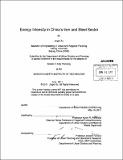Energy intensity in China's iron and steel sector
Author(s)
Xu, Jingsi, M.C.P. Massachusetts Institute of Technology
DownloadFull printable version (9.912Mb)
Other Contributors
Massachusetts Institute of Technology. Dept. of Urban Studies and Planning.
Advisor
Karen R. Polenske.
Terms of use
Metadata
Show full item recordAbstract
In this study, I examine the spatial and economic factors that influence energy intensity in China's iron and steel sector, namely industrial value added, renovation investment, coke consumption, and local coke supply. Despite the recognition of the importance of these spatial and economic factors in understanding energy intensity in the steel industry, the municipal and provincial governments of China have failed to integrate them into their energy policy making. Therefore, in order to seek the most effective ways of reducing energy intensity and to encourage energy conservation behavior in China's iron and steel sector, I make three simulations based on the (1) shifts in direct energy efficiency in the sector, (2) coke consumption during the iron and steel making processes, and (3) manufacturing material transportation. I propose an analytical framework for examining the differences in energy intensity at the regional level that are attributed to these spatial and economic factors. More specifically, among these four key factors presented in the multi-level regression models, I identify three factors-industrial value added, renovation investment, and coke consumption indices- as "spatial-level" or "time-variant" factors. I treat the fourth one-local coke supply-as the only "temporal-level" or "time-invariant" factor. I present three major implications for the energy policy-making regarding the development of a "green" iron and steel sector in China. First, when I incorporate all four key factors-industrial value added, renovation investment, coke consumption, and local coke supply-I obtain significantly improved overall exploratory power of the regional-level energy intensity model. Second, the results of my national-level input-output analysis show that policy makers should focus on the changes in total energy intensity, which includes both direct (40 percent) and indirect (60 percent) energy intensity, to design, implement, and evaluate energy-efficient policies for China's iron and steel sector. Third, my study sheds light on the most recent national-level development plan the "1 2 th Five-Year' Plan-and I argue that by adopting efficient industrial structure upgrading strategies, the iron and steel sector can dramatically reduce the national energy consumption in China in the near future.
Description
Thesis (M.C.P.)--Massachusetts Institute of Technology, Dept. of Urban Studies and Planning, 2011. Cataloged from PDF version of thesis. Includes bibliographical references (p. 105-108).
Date issued
2011Department
Massachusetts Institute of Technology. Department of Urban Studies and PlanningPublisher
Massachusetts Institute of Technology
Keywords
Urban Studies and Planning.